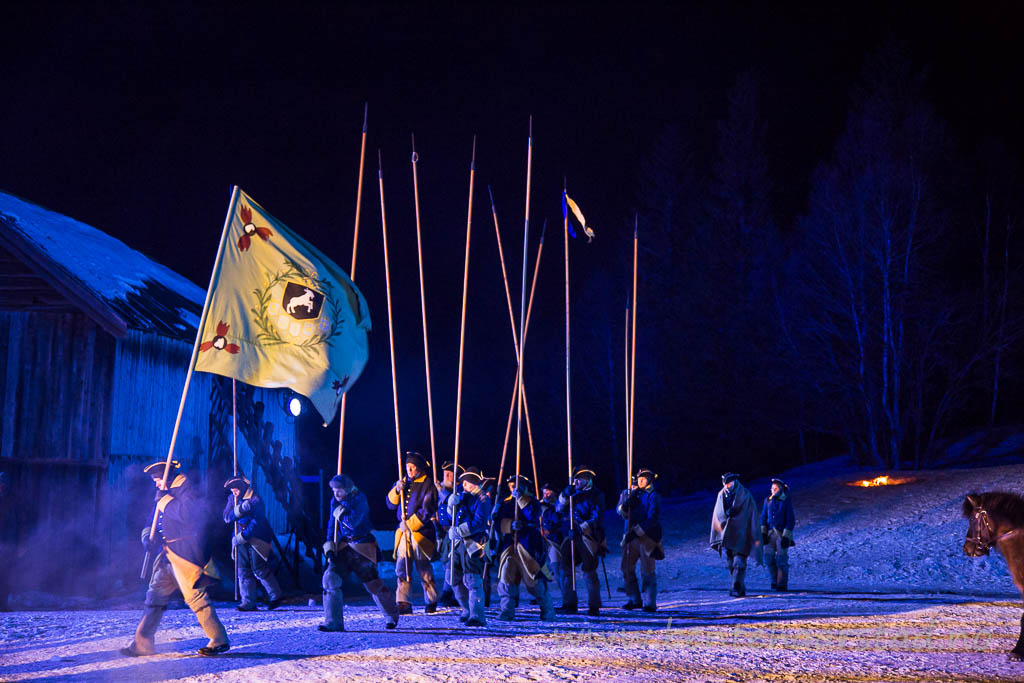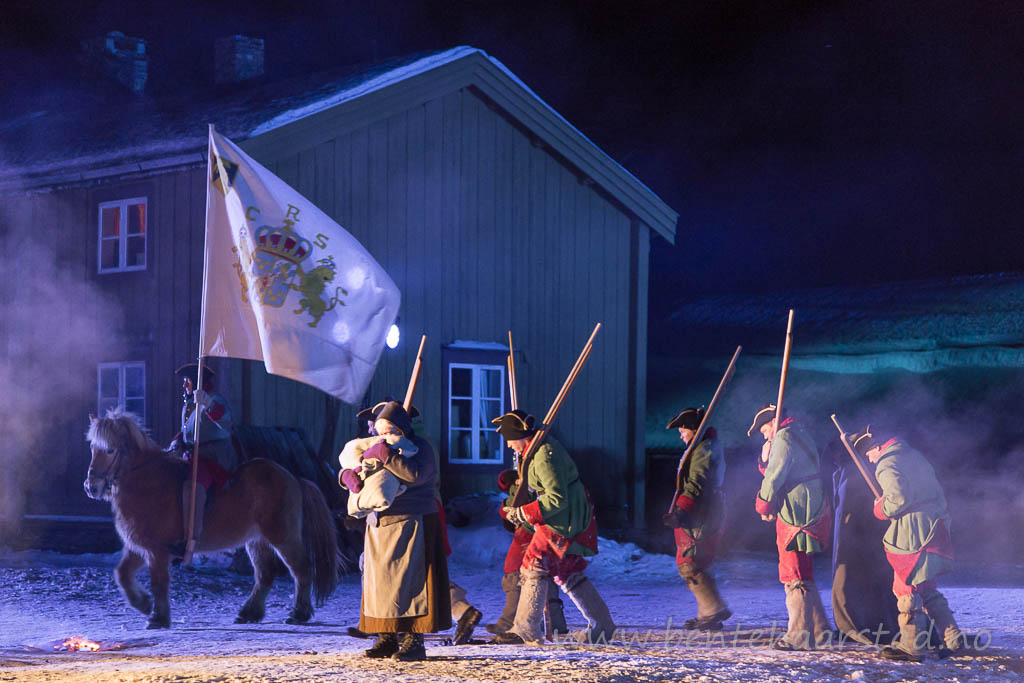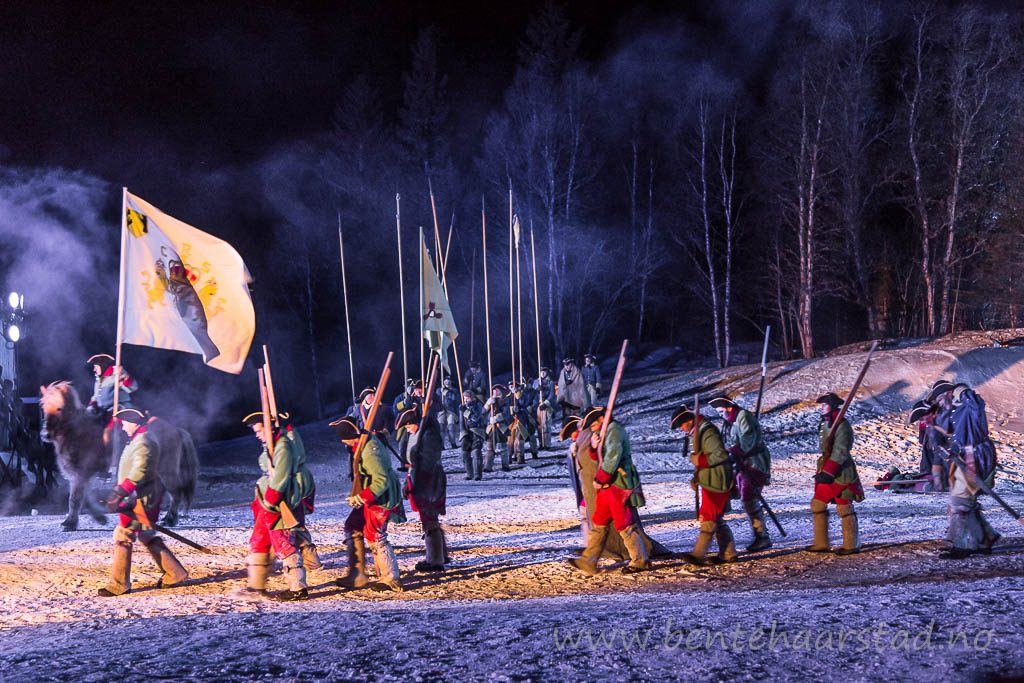Outdoor historical plays (spel) are quite common in Norway, but not in January. Acting in a mountain village in the middle of winter is a great effort, since the weather is normally freezingly cold. This weekend the play Karolinerspelet was performed in the small village Tydal. It is 300 years since Sweden tried to conquer Norway, in 1718. It was a failure and more than 3000 Sweedish soldiers froze to death on their way home crossing the mountains on the border. Additional 900 perished after they came to Sweden, and many were crippled after The Carolean Death March.
It was on New Years night 1718 that 5.000 Swedish soldiers arrived in Tydal, the last village before the mountains. It is a big task for a small community of just 850 people to stage such a play. It was four years sine last time, and about 200 people and 30 horses participated. Only the director and a couple of the actors are professionals. But Karolinerspelet 2018 was impressive like before.
Since it is exactly 300 years since this tragedy happened there will be a lot of events to honor the tragedy in this region, that is in Central Norway, some in cooperation with the Swedes. As by the old fortress Kristiansten in Trondheim, on the 19th of August, as you can see on this link. Because our peoples were always friends, even if somebody tried to make a war. For 300 years now there have been peace, and may it continue.
There are many books about this big tragedy, but I feel that our time is not that interested in historiy. That makes plays like this more important. Because we should not forget, and we should learn from history.
An immediate account of the horrors suffered by the Swedes was filed in a report by Major Emahusen who led his men up the mountain in pursuit of the Swedes after the blizzard had subsided. They were met by an unforgettable sight:
“I am not capable to fully describe the demise of the Swedish army as I have witnessed it (…). Throughout the Mountains, there are no firewood to be found, and when last man marched up on the mountain, the foul weather set in and lasted for four days. It was a sad and gruesome sight! Men lay dead in piles of 30, 40, 50 and more, in full battle dress with rucksack on their backs. Some still clung to their weapons, and some even had food their mouths; riders stood head first in the snow along the route, as if they were discarded by their horses. Many had knocked the butts of their guns to make fire with – no, I can not describe it! The longer up the mountain we went, the more dead people and horses were to be seen.
Only few of the cavalry as well as infantry could have gotten across the mountain. And they who succeeded must be frozen regardless of rank. Alas, the weather and the cold was piercing. (…). Loaded sledges were frozen in their tracks with their coachmen and dead horses in place…”. There are more information in English on this link from the Norwegian defence museum.
Here a link to a short movie about the The Carolean Death March. (in Swedish/Norwegian)
Here are links to my former blog post about this play, this history.
And to more of my pictures, from Karolinerspelet 2018, and from Karolinerspelet 2005-2014.






Thanks for the good information about the history of this evenement en the fantastic photos
LikeLike
Thank you very much Natuurfreak.
LikeLike
Awesome pics….
LikeLike
Thank you very much Candy S.
LikeLike
Jaw dropping impressive story and the impressive photos.
Then, think, are we wiser now ? ? ?
LikeLike
Wiser now? Probably not, even if Norway and Sweden did not have a war between them in these 300 years. Thank you Yoshizen.
LikeLike
Superb images of this re-enactment, Bente. I agree with you in that these plays are very important in reminding children and adults alike of the past.
Excellent lighting in these shots and wonderfully sharp in focus.
LikeLike
And I think it is also important for local communities to remember common history, and doing such big projects together. For bonding and identity. Even if this story is such a sad one. Thank you Vicki, night photography is not that easy, even with interesting lighting on the stage, whick in this place is very big.
LikeLiked by 1 person
Thank you for this informative post, Bente. We (over here in North America) rarely hear about things like this and it’s not something we learn much about in our history courses, so I find this most interesting (sad too, in this case). I must look up more about it now that you’ve kindled the fire.
LikeLike
It is not much we learn about it either (I believe). And it seems the national media, in both Norway and Sweden, is less interested in what happens outside the big cities now, less than before. Now it is Oslo and Stockholm area that is focus of attention. Thank you Anneli, we learn from each other.
LikeLiked by 1 person
I know! The world is changing so much — and not always in a good way.
LikeLike
Hi Bente,
Great info, and superb photography as usual 🙂
Thank you.
Cheers !
LikeLike
Glad you like it Hans, and thank you.
LikeLike
Ces photographies sont absolument fantastiques.
Merci de ce voyage dans le temps 😀
LikeLike
How very sad! I had never heard of this tragedy before. Thank you for sharing your History with us and may we all learn from such futile invasions and let peace prevail. 👍
LikeLike
My father’s parents immigrated from Sweden around 1900, on a boat from Gävle, which at the time was known as Gefle. They didn’t know each other until after they arrived in America; they met and married in Minnesota. When I was a child, the only battle I knew about was the Battle of Copenhagen, because of the silly verse that everyone in their small Iowa town — Swedes, Norwegians, Danes — laughed at:
“Ten thousand Swedes ran into the weeds at the Battle of Copenhagen;
ten thousand Swedes ran into the weeds, chased by one Norwegian.”
Everyone laughed at the little joke, but my grandparents never talked about the history of Sweden; they were trying to learn the history of America. I only learned about the Battle of Copenhagen as an adult, and now I have another bit of Swedish history to absorb. I’ve never heard of this, and what a tale it is.
I think it’s wonderful that the people make so much effort to make the reenactment possible. I’m glad you posted about it, and it’s something I will explore further. It’s really too bad that when we studied history in school, there was almost nothing about the Scandinavian cultures. It was only from our families that we learned — I’m glad to have this new way to learn, now.
LikeLike
Your photos are remarkable. It’s amazing this community does this tribute so well. I agree it’s important not to forget, and to learn from history. Thanks for sharing this with the world.
LikeLike
So interesting to replay the travails of neighboring countries. Your photographs as always are wonderful. Thank you for sharing this story.
LikeLike
Much of history, I’m sorry to say, is about one group of people trying to dominate, or actually dominating, another group.
LikeLiked by 1 person
A heartfelt account of this historical tragedy Bente. Senseless indeed.
LikeLike
A little late, Bente, but these are beautiful images. Aren’t all wars senseless?
LikeLike
I was only recently thinking about this awful historic event, little realizing it was 300 years almost to the month. Having visited the area I feel more empathy for the victims and for this story. Thanks for sharing these stunning photos. It really comes to life. I am glad that the sacrifice of those who died is remembered.
LikeLike
I never heard of this. Horrific. It is good to remember what went before.
LikeLike